
Tools to Remove Illegal Street SignsCAUSS - Citizens Against Ugly Street Spam
How to remove signs on telephone polesDo you want to know how to take down signs on telephone poles? There are a number of tools you can make and use to make it easier to remove illegal "street spam" signs - particularly signs nailed out of reach on telephone poles. This section explains some of these tools.1 Sharky Stick
Parts and Assembly for a Sharky StickTM One piece of EMT Heavy duty electrical tubing 1 inch diameter x 10 feet long. 10 feet will make two sticks - one for a truck and one for a smaller vehicle. For easier handling have the store cut off one piece 4.5 foot long, leaving a 5.5 foot piece. If you can find a short piece that's already cut about 4.5 foot long, that will make up one stick.
Two 3/8 inch steel bolts - 4 inches long (standard thread OK). Drill a 3/8 inch hole in one end of the EMT tubing about 1.5 to 2.0 inches from the end. Run the bolt thru the hole with washers next to tubing, then screw on bolt and tighten. Don't over torque, you could strip the lock nut or break the bolt. You can grind the end of the bolt off to suit taste, but not too sharp. Two sticks will run about $10.00 if purchased at a home improvement center like Lowe's or Home Depot. For those driving pickups the 5.5 footer fits in the bed of the truck and doesn't continuously roll around. The 4.5 footer will easily fit in a car trunk or Jeep. For the ladies, a 4 foot stick works well (max length of 4.5 feet). A 4.5 stick will allow a 6 foot person to have knock down power up to 11 feet high. If you get much over 11.0 ft - a Sharky Hook is strongly recommended. Sharky Hook (High Stick)
Parts and Assembly for Sharky Hook (High Stick):
One 4 inch paint roller with 12 inch or 16 inch neck or shank.
Remove plastic keeper for paint roller. Caution: This high tool should be used for only those signs that are stapled and not nailed, up high on the pole. This tool will not take heavy pulling or strikes at the signs. Bear Claw
The prongs are somewhat sharp and, being solid steel, there's a decent mass on the far end of the pole that will quite easily penetrate even the toughest coroplast without the need for a wild swatting motion that could be dangerous. The tip penetrates and grabs nicely so that a gentle tug pulls down the sign, thanks to the bulging shape. 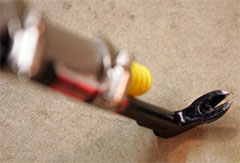
Winter-Garten tool
Sharky Cutter
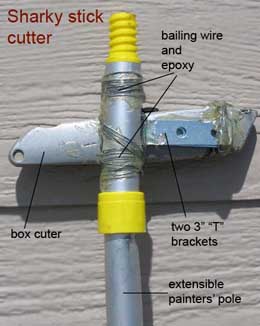
Parts and materials for the Sharky Cutter: Extensible painters' pole. These come in various materials and lengths. Fiberglass is the heaviest and is also safest because it is non-conducting. A 4 foot aluminum "twist lock" pole is good enough for most applications.
Stanley 10-400 box cutter, or any box cutter that allows blade replacement without opening the unit. Place the two "T" brackets together for strength. Use lengths of bailing wire to secure the "T" brackets to the end of the extensible painters' pole. Use lengths of bailing wire to secure the box cutter to the "T" brackets. Make sure not to block sliding parts that are part of the blade eject mechanism. It may help to file a few notches on the box cutter. Apply epoxy over and underneath the bailing wire to hold everything in place. Sharky Cutter - version 2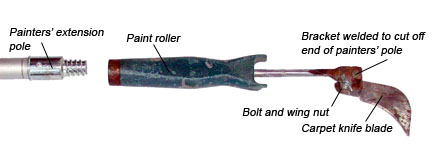
The Sharky Cutter is intended to be used to cut signs that are nailed with heavy nails and washers to utility poles. When the basic Sharky StickTM won't do the job, simply cut off the ends of the sign, leaving a narrow strip with nails intact. To make this tool, cut off the end of a paint roller. Then weld two metal tabs to the cut-off end. Drill a hole in the metal tabs and bolt on a hooked carpet knife blade. Screw it into a fixed-length or extensible painters' pole (you can carry extensions of various lengths). The curved blade makes all the difference - it cuts through coroplast like like a hot knife through butter. Sharky PainterCAUSS recommends complete removal of illegal signs. However, it is sometimes impossible to remove wooden signs securely nailed or screwed to a utility pole. The following tool was used one time by one shark to block out phone numbers on a half-dozen illegal signs.
This tool can be added on to the end of a Sharky Cutter, described above. Parts and materials for the Sharky Painter: Extensible painters' pole. These come in various materials and lengths. Fiberglass is the heaviest and is also safest because it is non-conducting. A 4 foot aluminum "twist lock" pole is good enough for most applications.
Can of black exterior enamel spray paint. Tape the spray paint to the paint brush extension or paint roller. Tape the hinge to the spray can and paint brush extension or paint roller. The hinge should close down on top of the paint can nozzle. (Check the hinge swing before attaching). paint brush extension or paint roller. Tie the string through the end of the hinge, or tie it to a clip that can be attached to the end of the hinge. Keep the paint can lid on when you are not using the tool in order to avoid accidental discharge. Milwaukee 11 piece job saw utility kit
But most importantly - you can thread it on to a standard extension pole! The Shark Line
Cut a 2" section of 3/4" PVC water pipe elbow. Loop the rope several times through the pipe for weight. Don't add on too much weight in case you yank the rope too hard and the object flies towards you. 
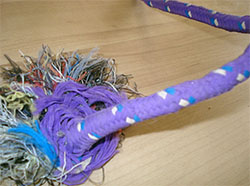
It is very easy to toss the pipe over a sign and yank the sign down even when it is 12 feet high. Throw the pipe end over the sign and hook it behind the sign, then give a good tug to pull the sign down. You can loop the loose end of the rope through the pipe and make a lasso if you need it for a really tough sign. You can also tie an end to a short stick for leverage. This tool rolls up into a small size which easily stores in a ditty bag on your bike. Here's another version made with thinner rope: 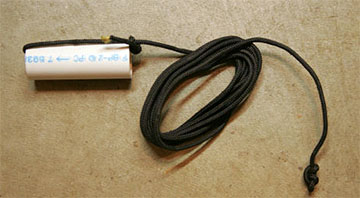
Cautions1. CAUSS does not condone or support activities that are in violation of the law - in fact, we encourage cooperation with Code Enforcement agencies. The material presented on this page and website is for informational purposes only. You assume all responsibility for construction of and use of the tools presented on this page and this website. When using ladders or any of these tools, be careful! Be careful with knives, sharp tools and box cutters. Do not swing a tool where it could come into contact with electrical wires. When stopping to remove illegal signs, do not obstruct traffic, and obey traffic laws. Be safe! |
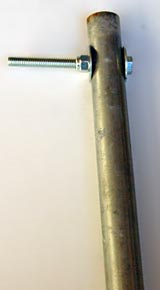 The Sharky Stick
The Sharky Stick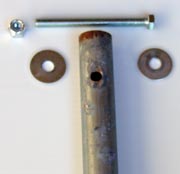
 The "sharky hook" is a tool used to reach up and hook a sign nailed to a utility pole. It is built to reach up and grab signs mounted high on the utility pole where a Sharky Stick can not effectively be swung.
The "sharky hook" is a tool used to reach up and hook a sign nailed to a utility pole. It is built to reach up and grab signs mounted high on the utility pole where a Sharky Stick can not effectively be swung.
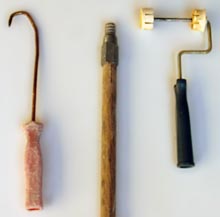
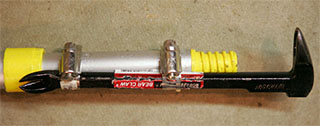 This tool is an extensible painter's pole with a 'Bear Claw' brand of small nail puller attached using ordinary automotive hose clamps.
This tool is an extensible painter's pole with a 'Bear Claw' brand of small nail puller attached using ordinary automotive hose clamps.

 This gardening tool is manufactured by the German company Winter-Garten and is available under the Winter-Garten or Ronco brand at Lowe's for about $34. This is less durable and much more expensive than a Sharky Stick
This gardening tool is manufactured by the German company Winter-Garten and is available under the Winter-Garten or Ronco brand at Lowe's for about $34. This is less durable and much more expensive than a Sharky Stick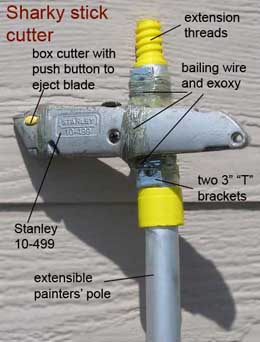 The Sharky Cutter is intended to be used to cut signs that are nailed with heavy nails and washers to utility poles. When the basic Sharky Stick
The Sharky Cutter is intended to be used to cut signs that are nailed with heavy nails and washers to utility poles. When the basic Sharky Stick
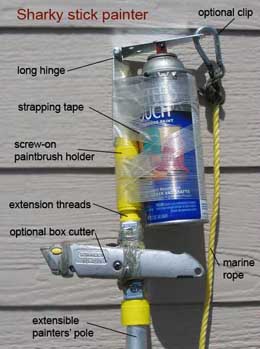
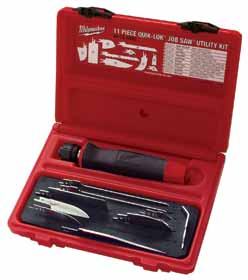 This "Job Saw" by Milwaukee Tools has interchangable blades, including a pocketknife style blade and several utility knife style blades, too. It will also accept any standard recipricating saw (Sawzall) blades.
This "Job Saw" by Milwaukee Tools has interchangable blades, including a pocketknife style blade and several utility knife style blades, too. It will also accept any standard recipricating saw (Sawzall) blades.
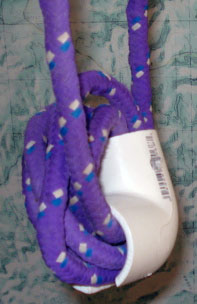 Cycling with a long pole is not recommended, nor is is convenient. This tool is a 10 foot length of 1/4" kevlar rope with a nylon weave covering it. This is fantastically-strong stuff. It does not stretch and with a 7,000 lb tensile strength, it will not break. It is also non-conductive - but don't use near power lines on a rainy day. (Also keep in mind that electrical problems could cause a telephone pole to become "hot".)
Cycling with a long pole is not recommended, nor is is convenient. This tool is a 10 foot length of 1/4" kevlar rope with a nylon weave covering it. This is fantastically-strong stuff. It does not stretch and with a 7,000 lb tensile strength, it will not break. It is also non-conductive - but don't use near power lines on a rainy day. (Also keep in mind that electrical problems could cause a telephone pole to become "hot".)